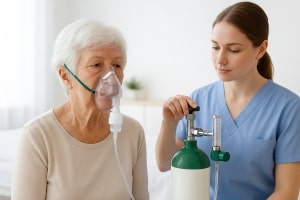 Pulmonary hypertension has no known cure, though there are treatments that can help you manage this condition. One such option is oxygen therapy, which can alleviate shortness of breath and make it easier to participate in your day-to-day activities. Some people even find that they think more clearly and experience less chest discomfort. We’ve gathered what you need to know about how oxygen therapy can improve your quality of life when you have pulmonary hypertension.
Pulmonary hypertension has no known cure, though there are treatments that can help you manage this condition. One such option is oxygen therapy, which can alleviate shortness of breath and make it easier to participate in your day-to-day activities. Some people even find that they think more clearly and experience less chest discomfort. We’ve gathered what you need to know about how oxygen therapy can improve your quality of life when you have pulmonary hypertension.
How Oxygen Therapy Helps Reduce Symptoms
Normally, when you breathe in, oxygen travels to your lungs, where it is collected and distributed into the bloodstream via the air sacs. The oxygen is then shuttled to every part of your body, which is essential because everything from your muscles to your brain requires oxygen to work properly.
But pulmonary hypertension makes this whole process much more difficult because it causes a narrowing of the blood vessels and thickening of the right side of the heart. The result is that blood flows less efficiently through the lungs. A lower quantity of blood travelling through the lungs to get oxygenated means that less oxygen reaches the rest of your body.
This shortage of oxygen is often the cause of many of the symptoms you may experience, including feeling constantly tired, experiencing brain fog, or getting out of breath when doing simple things.
A normal breath of regular air consists of about 21% oxygen. Oxygen therapy helps by increasing the concentration of oxygen you inhale, allowing more oxygen to enter your bloodstream at once.
What Research Shows About Oxygen Therapy
Interestingly, oxygen therapy has multiple effects on your body. For example, some studies have found that oxygen may help the blood vessels in your lungs relax, thereby temporarily reducing the high pressure that’s causing problems. Researchers have found that patients who use oxygen for just 15 to 30 minutes improve their blood pressure measurements.
A large study called REVEAL followed over 3,000 patients with pulmonary hypertension for several years. The researchers discovered something important: patients who had severe difficulty transferring oxygen from the air into their blood lived longer when they used supplemental oxygen compared to those who didn’t use it.
More recently, a study called SOPHA specifically examined the effects of using oxygen therapy for three months. The results were encouraging, revealing that patients who used oxygen therapy could walk significantly farther in exercise tests compared to those who didn’t receive oxygen.
Different Ways to Get Oxygen Therapy
 There are different ways to access oxygen therapy, with the delivery method largely depending on your needs and lifestyle. The most common approach involves a nasal cannula, which is basically a thin plastic tube with small prongs that fit into your nostrils. The advantage is that, while you are being treated, you can move around normally and even eat, talk, or drink.
There are different ways to access oxygen therapy, with the delivery method largely depending on your needs and lifestyle. The most common approach involves a nasal cannula, which is basically a thin plastic tube with small prongs that fit into your nostrils. The advantage is that, while you are being treated, you can move around normally and even eat, talk, or drink.
If you require oxygen most of the time, including during sleep, your doctor may recommend a standard oxygen concentrator. These machines plug into your wall outlet and work by taking regular air and concentrating the oxygen from it. They’re about the size of a small end table and usually have wheels, allowing you to move them around your house.
On the other hand, if you want to stay active outside your home, you can opt for a portable oxygen concentrator. It’s a compact device that runs on rechargeable batteries and is lightweight enough to take with you when you go shopping, visit friends, or travel. Most weigh less than 10 pounds and can provide oxygen for several hours.
Some patients use compressed oxygen tanks, though these can be heavy and must be refilled or replaced regularly. Liquid oxygen systems are also available, but they tend to be more expensive and require special handling.
Who Should Use Oxygen Therapy
At the moment, oxygen therapy is primarily recommended for individuals with relatively low oxygen levels. To determine if you would benefit from this type of therapy, you will have to get an oxygen level test done at your doctor’s office.
It requires the use of a simple device that clips onto your finger, but your doctor may also conduct a blood test. Based on the results, as well as your symptoms and how active you want to be, they’ll help you decide if oxygen therapy is a good option for you.
Making Oxygen Therapy Work for You
 While oxygen therapy helps many people with pulmonary hypertension feel better, it does come with some adjustments. You’ll need to learn how to use and maintain your equipment, and you may need to plan ahead when leaving home.
While oxygen therapy helps many people with pulmonary hypertension feel better, it does come with some adjustments. You’ll need to learn how to use and maintain your equipment, and you may need to plan ahead when leaving home.
Some people initially feel self-conscious about using oxygen equipment in public. This is completely normal, and most patients find that the benefits of feeling better far outweigh any initial awkwardness. Many oxygen systems are quite discrete, and people are generally understanding about medical equipment.
Getting Expert Care for Your Pulmonary Hypertension
Managing pulmonary hypertension successfully requires working with healthcare providers who understand this complex condition and can coordinate all aspects of your care.
Imperial Center Family Medicine has extensive experience helping patients manage cardiovascular conditions while providing the personal attention and ongoing support that make a real difference in their health outcomes. Contact us today at 919-873-4437 or online to discuss how our experienced team can help create a complete treatment plan personalized for your specific needs and determine if oxygen therapy is beneficial for your situation.
